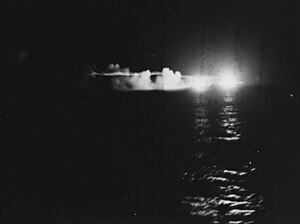The Battle of Kolombangara (Japanese: コロンバンガラ島沖海戦) (also known as the Second Battle of Kula Gulf) was a naval battle of the Pacific campaign of World War II, fought on the night of 12/13 July 1943, off Kolombangara in the Solomon Islands.
Background[]
A Japanese "Tokyo Express" reinforcement force—commanded by Sho-sho (Rear Admiral) Shunji Izaki and comprising the light cruiser Jintsu, the destroyers Mikazuki, Yukikaze, Hamakaze, Kiyonami and Yugure and the destroyer transports Satsuki, Minazuki, Yūnagi, and Matsukaze—made a run down "The Slot" from the upper Solomons to land troops at Vila on Kolombangara by way of Kula Gulf on the night of 12 July 1943.
An Allied force—commanded by Rear Admiral Walden L. Ainsworth and comprising the United States Navy light cruisers USS Honolulu and St. Louis and Royal New Zealand Navy light cruiser HMNZS Leander, and the destroyers USS Nicholas, O'Bannon, Taylor, Jenkins, Radford, Ralph Talbot, Buchanan, Maury, Woodworth, and Gwin—were deployed in a single column with five destroyers in the van followed by the light cruisers and then by five destroyers in the rear.
The U.S. had landed troops of the 37th Infantry Division on New Georgia to attack Munda the week before and had just placed Marine Raiders ashore at Rice Anchorage on New Georgia's northern shore to seize Bairoko. Admiral Ainsworth's mission was to protect the north shore beachhead from attack by the "Tokyo Express" and if possible to prevent Imperial reinforcements from landing.
Battle[]
At 01:00 on 13 July, the Allied ships established radar contact about 20 mi (17 nmi; 32 km) east of the northern tip of Kolombangara at 7°50′S 157°21′E / 7.833°S 157.35°ECoordinates: 7°50′S 157°21′E / 7.833°S 157.35°E. Ainsworth assumed he had complete surprise, but the Japanese had been aware of the Allied force for almost two hours. The destroyers increased speed to engage the Japanese force while the cruisers turned to deploy their main batteries, but the Imperial destroyers had already launched Long Lance torpedoes and turned away. Jintsu engaged the Allied ships, but all Allied fire was concentrated on the largest ship. Jintsu was reduced to a wreck while Leander was struck by a torpedo and, severely damaged, retired from the battle escorted by Radford and Jenkins. Jintsu was finally broken in two by torpedo hits and sank at about 01:45, with the loss of nearly her entire crew, including Vice Admiral Izaki.
Ainsworth pursued the Imperial destroyers, but both St. Louis and Honolulu were struck by torpedoes and damaged, while Gwin was struck amidships and scuttled at 09:30 the next morning.
Aftermath[]
Honolulu and St. Louis were out of action for several months, while Leander was under repair for a year and never returned to action during World War II.
Except for Jintsu, the Japanese force escaped damage, and the transport destroyers successfully landed 1,200 men at Vila. The Emperor's men had won a tactical victory, but of the action the naval historian Samuel Eliot Morison wrote: "A string of such victories added up to defeat."
Though at a severe cost, Ainsworth also accomplished his mission of preventing an attack on the Marines, and combined with the earlier Battle of Kula Gulf, successfully deterred the Japanese from future use of Kula Gulf in reinforcing Munda. After the Battle of Kolombangara, the Japanese chose to use Vella Gulf, Blackett Strait, and the more constricted passage at Wana Wana, resulting in a series of nightly attacks by U.S. destroyers and PT boats against their reinforcement efforts.
| Wikimedia Commons has media related to Battle of Kolombangara. |
Notes[]
References[]
- Brown, David (1990). Warship Losses of World War Two. Naval Institute Press. ISBN 1-55750-914-X.
- Crenshaw, Russell Sydnor (1998). South Pacific Destroyer: The Battle for the Solomons from Savo Island to Vella Gulf. Naval Institute Press. ISBN 1-55750-136-X.
- D'Albas, Andrieu (1965). Death of a Navy: Japanese Naval Action in World War II. Devin-Adair Pub. ISBN 0-8159-5302-X.
- Dull, Paul S. (1978). A Battle History of the Imperial Japanese Navy, 1941-1945. Naval Institute Press. ISBN 0-87021-097-1.
- Hara, Tameichi (1961). Japanese Destroyer Captain. Auckland & London: Collins Bros.
- Harker, Jack S. (1971). Well Done Leander. New York & Toronto: Ballantine Books. ISBN 0-345-27894-1.
- Hone, Thomas C. (1981). "The Similarity of Past and Present Standoff Threats". pp. 113–116. ISSN 0041-798X.
- Lacroix, Eric; Linton Wells (1997). Japanese Cruisers of the Pacific War. Naval Institute Press. ISBN 0-87021-311-3.
- Kilpatrick, C. W. (1987). Naval Night Battles of the Solomons. Exposition Press. ISBN 0-682-40333-4.
- McGee, William L. (2002). "Operation TOENAILS". The Solomons Campaigns, 1942-1943: From Guadalcanal to Bougainville--Pacific War Turning Point, Volume 2 (Amphibious Operations in the South Pacific in WWII). BMC Publications. ISBN 0-9701678-7-3.
- Morison, Samuel Eliot (1958). Breaking the Bismarcks Barrier, vol. 6 of History of United States Naval Operations in World War II. Castle Books. ISBN 0-7858-1307-1.
- Parkin, Robert Sinclair (1995). Blood on the Sea: American Destroyers Lost in World War II. Da Capo Press. ISBN 0-306-81069-7.
- Roscoe, Theodore (1953). United States Destroyer Operations in World War Two. Naval Institute Press. ISBN 0-87021-726-7.
External links[]
- Parshall, Jon; Bob Hackett, Sander Kingsepp, & Allyn Nevitt. "Imperial Japanese Navy Page (Combinedfleet.com)". Archived from the original on 13 June 2006. http://web.archive.org/web/20060613172444/http://www.combinedfleet.com/kaigun.htm. Retrieved 2006-06-14.
- Description by Vincent O'Hara
- WW2DB: Solomons Campaign
The original article can be found at Battle of Kolombangara and the edit history here.
